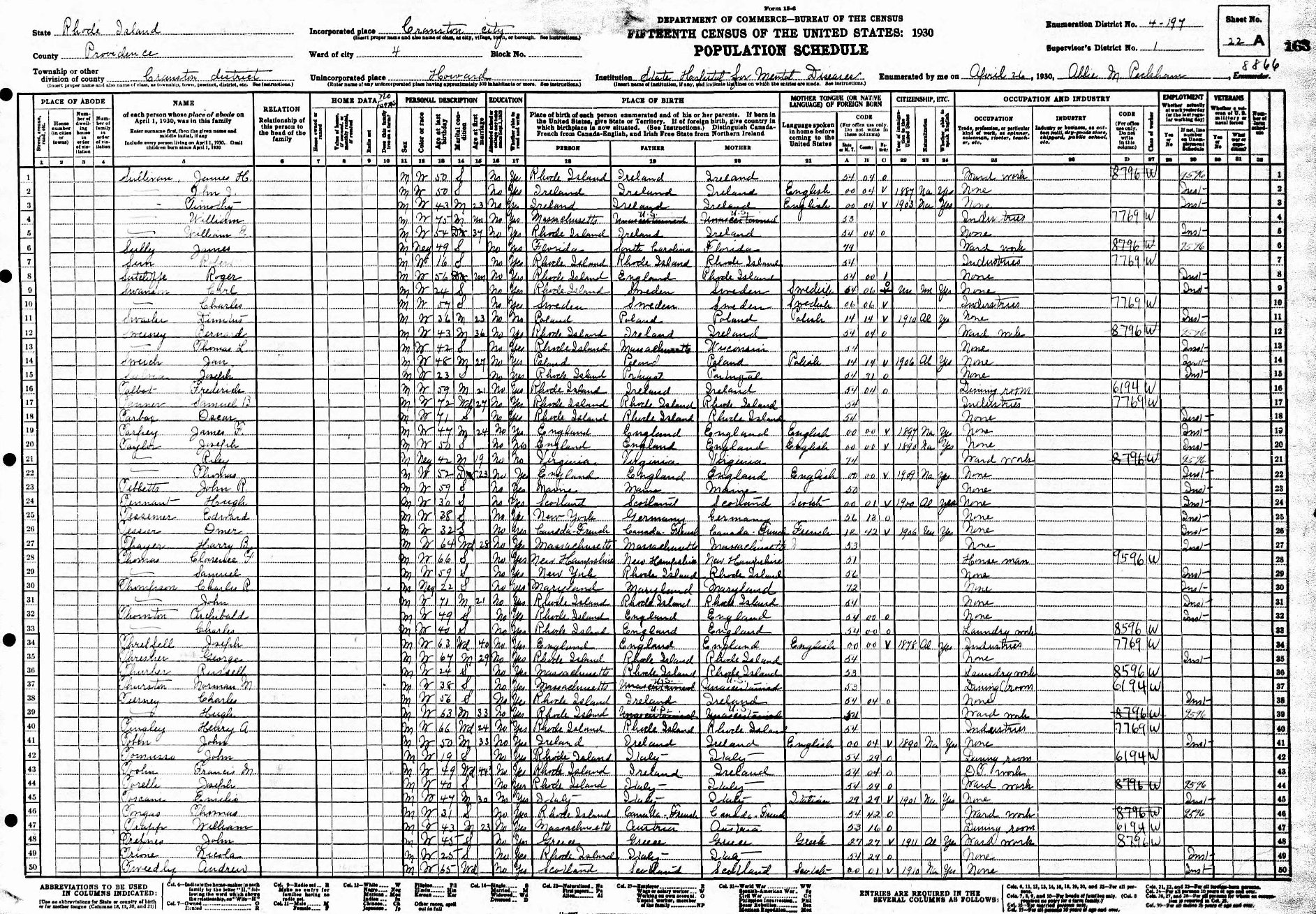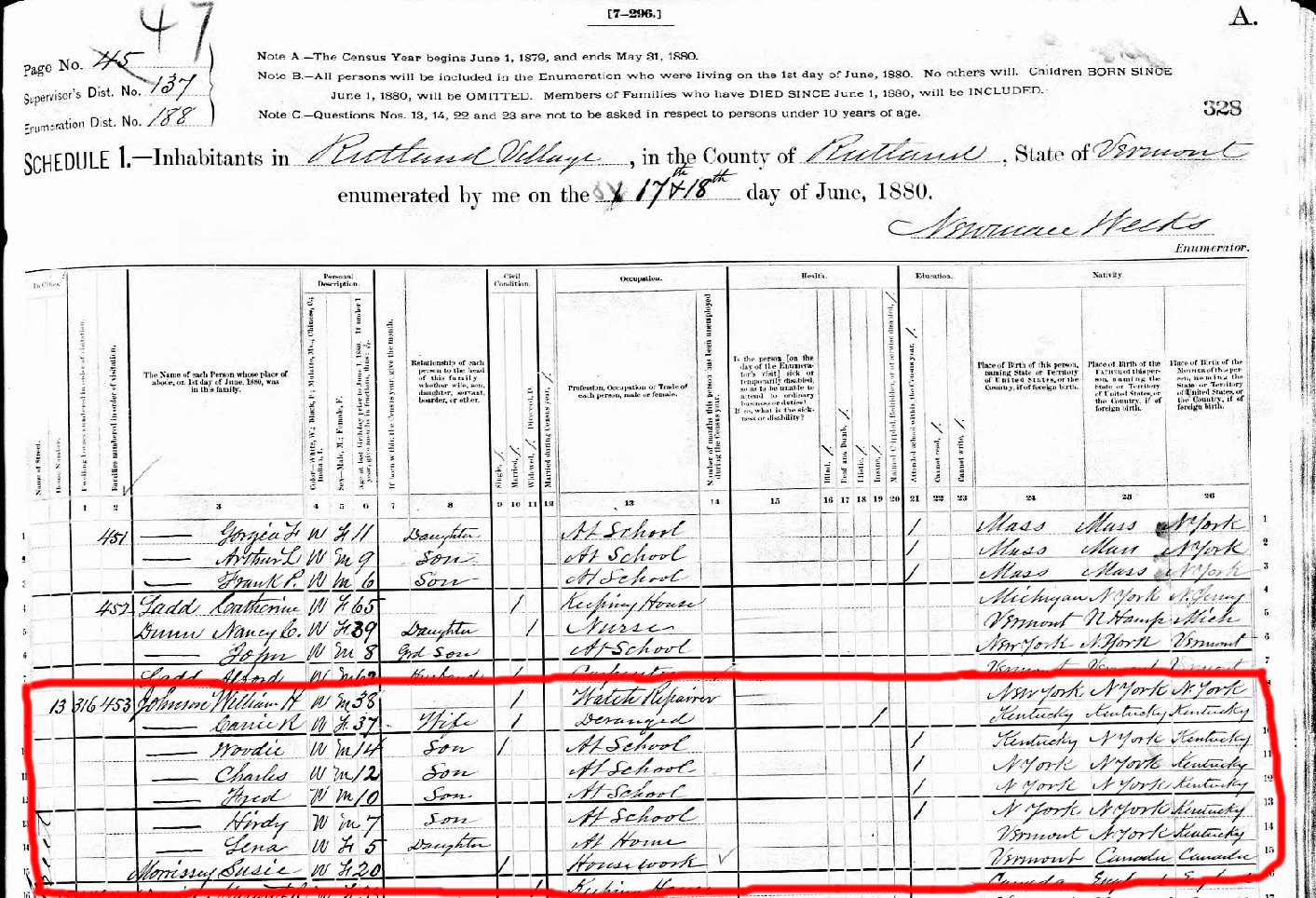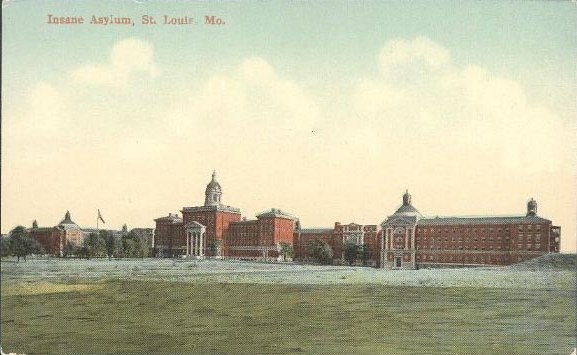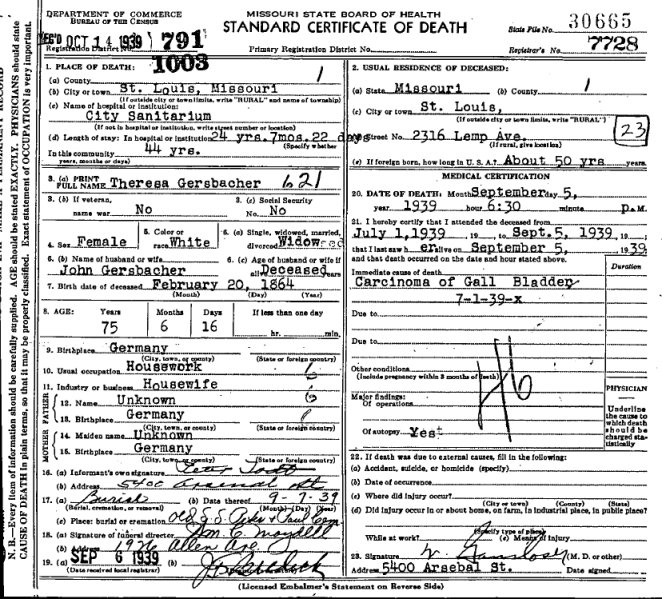In 1930, Samuel A. Thomas, the son of my 3rd-great-grandfather's sister Catherine Bennett Winters, resided at the State Hospital for Mental Diseases, located in the unincorporated place Howard, in Cranston, Providence County, Rhode Island.
1930 United States census, Cranston, Providence County, Rhode Island, population schedule, enumeration district no. 4-197, sheet no. 22A. Ancestry.com. 1930 United States Federal Census [database on-line]. Provo, UT, USA: Ancestry.com Operations Inc, 2002.
Samuel died on 11 May 1933 in Howard, Cranston, Rhode Island. He probably died at the State Hospital for Mental Diseases.
In 1869, the more than 417 acre William A. Howard farm in Cranston, Providence County, Rhode Island was purchased. The property was to be used for a state asylum for the insane and poor, a state workhouse, and a house of corrections. In 1870, eighteen wood-framed buildings were built, and in November, 118 patients were admitted to the asylum.
Music therapy began at the hospital in 1881, when twelve canaries and six cages were purchased and placed in the halls. In 1900, an orchestra was established; it included one patient musician. Another patient joined the orchestra in 1904. An organ was purchased in 1925. The same year, the hospital choir gave a concert at a local radio station.
Hydrotherapy began in 1927. Patients were given baths, wet sheet packs, salt glows, foot baths, needle sprays, fan douches, and rain douches. Hydrotherapy was most frequently used as a form of restraint; some patients received continuous baths.
Some patients did chores, such as housekeeping and farm labor. In 1930, Samuel A. Thomas did not do any work, but some of the other patients worked in the ward, laundry, dining room, or industries.
The State Hospital for Mental Diseases is now the Eleanor Slater Hospital.
References
Golden, Janet, and Schneider, Eric C. Custody and Control: The Rhode Island State Hospital for Mental Diseases, 1870, 1970. Rhode Island History 41(4), November 1982, pp. 113-125.
History- Rhode Island -Dept of Behavioral Healthcare, Developmental Disabilities and Hospitals
Covering genealogy, family history, historical events and places, and anything else related!
Showing posts with label Madness Monday. Show all posts
Showing posts with label Madness Monday. Show all posts
Monday, July 25, 2016
Monday, March 30, 2015
Madness Monday: Occupation: Deranged
My great-great-grandfather's sister Julia Tarkington married Frederick R. Johnson on 13 August 1898 in New York City. They separated less than a year later. Julia provided information about the Tarkington family to Edythe Rucker Whitley, and the compiled information includes the following statement about Julia's husband Fred: "He was so disipated [sic] that she was unable to live with him." Perhaps Fred took after his mother, Caroline R. "Carrie" (Dabbs) Johnson; she was listed as "Deranged" in the "Profession, Occupation, or Trade of each person, male or female" category in the 1880 United States census.
1880 United States census, Rutland Village, Rutland County, Vermont, population schedule, enumeration district 188, page 328A. Available from Ancestry.com and The Church of Jesus Christ of Latter-day Saints. 1880 United States Federal Census [database on-line]. Provo, UT, USA: Ancestry.com Operations Inc, 2010.
Here is a closeup of the family's enumeration:
1880 United States census, Rutland Village, Rutland County, Vermont, population schedule, enumeration district 188, page 328A. Available from Ancestry.com and The Church of Jesus Christ of Latter-day Saints. 1880 United States Federal Census [database on-line]. Provo, UT, USA: Ancestry.com Operations Inc, 2010.
Here is a closeup of the family's enumeration:
Monday, December 29, 2014
Madness Monday: City Sanitarium, St. Louis, Missouri
St. Louis Insane Asylum. Postcard, 1920s. Available from Built St. Louis.
The St. Louis County Lunatic Asylum was designed by William Rumbold. Construction began in August 1864, and the facility, located at 5400 Arsenal Street, opened on 23 August 1869. Its capacity at that time was 250 patients. When the City of St. Louis separated from St. Louis County in 1876, the name of the institution was changed to St. Louis City Insane Asylum. In 1910, its name was changed to City Sanitarium. Additional wings were added in 1912.
My great-great-grandfather John Gersbacher died in 1914. After his death, his widow Theresa (Vollmer) Gersbacher entered the City Sanitarium. At the time that she entered, clinical diagnoses were not given to patients. Some people ended up at the sanitarium just because they were poor. Treatments included straitjackets, placing people into vats of ice cold water, and placing people into small cubicles with straw floors.
Theresa was enumerated at the City Sanitarium in the 1920 United States census and in the 1930 United States census. She died there on 5 September 1939. According to her death certificate, she had been in the sanitarium for 24 years, 7 months, and 22 days.
Theresa Gersbacher death certificate. 5 September 1939. Missouri State Board of Health.
In 1948, the City Sanitarium became a state institution, and its name was changed to the St. Louis State Hospital. In October 1997, the hospital moved to 5300 Arsenal St. and changed its name to St. Louis Psychiatric Rehabilitation Center.
References
Built St. Louis: Recalled to Life: St. Louis State Hospital
The Hill: Institutions
Hoosiers and Scrubby Dutch: St. Louis's South Side
St. Louis Psychiatric Rehabilitation Center
Subscribe to:
Posts (Atom)







